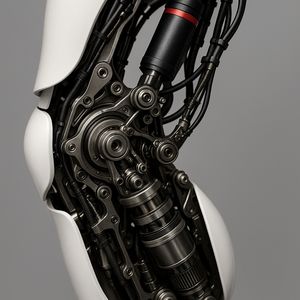Inside the Anatomy of Humanoid Robots: Actuators, Sensors, and More
Discover the key components that bring humanoid robots to life, including actuators, sensors, and control systems, and learn how they mimic human abilities.
November 23, 2025
Overview
Humanoid robots have captured the imagination of engineers and enthusiasts alike, serving as a bridge between science fiction and technological reality. These human-like machines are designed to replicate human behavior, movement, and even emotion, thanks to a combination of cutting-edge components working in harmony. In this blog post, we’ll explore the core building blocks of humanoid robots—focusing on actuators, sensors, and control systems—and how these elements enable robots to perform complex tasks with precision and adaptability.
Technology Breakdown
1 Actuators: The Muscles of Humanoid Robots
Actuators are the essential components that allow humanoid robots to move. They function like muscles, converting energy into motion. Depending on the design and purpose of the robot, actuators come in various types:
-
Electric Actuators: These are commonly used in smaller robots due to their precision and efficiency. They rely on electric motors to generate movement. For example, Tesla’s Optimus robot utilizes electric actuators for its lightweight and energy-efficient design.
-
Hydraulic Actuators: Known for their strength, hydraulic actuators are often used in robots designed for heavy lifting or industrial applications. Boston Dynamics’ Atlas robot employs hydraulic actuators for its powerful and dynamic movements.
-
Pneumatic Actuators: These actuators use compressed air to produce motion. While not as precise as electric actuators, they are lightweight and suitable for robots requiring softer, more human-like movements.

2\. Sensors: The Eyes, Ears, and Skin of Robots
Sensors play a critical role in enabling humanoid robots to perceive their environment. These devices collect data from the surroundings, allowing robots to make decisions and interact intelligently. Key sensor types include:
-
Vision Sensors: Cameras and LiDAR systems help robots recognize objects, detect obstacles, and navigate environments. For example, robots like Figure AI’s humanoid use stereo cameras for depth perception.
-
Touch Sensors: These sensors mimic the human sense of touch by detecting pressure, temperature, and texture. Advanced robots, such as those from Shadow Robot Company, integrate tactile sensors to grasp objects delicately.
-
Proprioceptive Sensors: These internal sensors monitor the robot’s position, joint angles, and balance. Gyroscopes and accelerometers are common proprioceptive sensors, essential for maintaining stability in bipedal robots.
-
Auditory Sensors: Microphones and sound localization systems enable robots to process speech and environmental sounds, enhancing their interaction capabilities.
Image Prompt 2: A humanoid robot interacting with its environment, using tactile sensors to hold a fragile object like a glass cup.
3\. Control Systems: The Brain Behind the Operation
While actuators and sensors provide the physical and sensory capabilities, control systems serve as the brain of humanoid robots. These systems interpret sensor data and send commands to actuators to achieve desired actions. Modern control systems are powered by advanced AI algorithms, which enable:
-
Real-Time Decision-Making: Robots like Tesla Optimus leverage AI models to analyze sensory data and make split-second decisions, such as avoiding obstacles or adjusting gait.
-
Motion Planning: Sophisticated algorithms allow robots to plan their movements in advance, ensuring fluid and human-like motion.
-
Adaptability: AI-powered control systems enable robots to learn from their environment and improve performance over time, a concept known as reinforcement learning.
Case Study: Boston Dynamics’ Atlas robot demonstrates the synergy between actuators, sensors, and control systems. Its ability to perform acrobatic feats, such as backflips, is a testament to how these components work together seamlessly.
Industry Impact
The integration of advanced actuators, sensors, and control systems is revolutionizing various industries. Here’s how humanoid robots are making an impact:
- Healthcare:
\- Robots equipped with touch and vision sensors assist in surgeries and patient care. - Humanoids like SoftBank Robotics’ Pepper provide companionship and support for the elderly.
- Manufacturing:
\- Industrial humanoids streamline production lines by performing repetitive tasks with precision. - Robots like Tesla Optimus are being developed to automate tasks that are dangerous or tedious for humans.
- Customer Service:
\- Humanoid robots are being deployed in retail and hospitality to interact with customers, answer questions, and even provide entertainment.
- Space Exploration:
\- NASA’s Robonaut is designed to perform tasks in space environments that are too dangerous for astronauts, utilizing advanced sensors and actuators.
Visual Highlights
Image Prompt 3: A futuristic humanoid robot in a hospital setting, assisting a patient by handing over a glass of water.
Image Prompt 4: A humanoid robot navigating a complex industrial environment, lifting a heavy mechanical part with precision.
Conclusion
Humanoid robots are a marvel of modern engineering, combining actuators, sensors, and control systems to replicate human abilities. As these technologies continue to evolve, the capabilities of humanoid robots will only expand, enabling them to play a larger role in industries ranging from healthcare to manufacturing and beyond. For robotics enthusiasts and professionals, understanding these core components is the first step to appreciating the complexity and potential of humanoid robots.
By continuing to innovate in these areas, we’re not just building robots—we’re shaping the future of human-robot collaboration.
Related Topics
-
Humanoid Robot Design
-
AI-Powered Motion Control
-
Robotics in Healthcare
Related Articles
What's New in Humanoid Robotics - November 6-13, 2025
This week's top updates in humanoid robotics
Read MoreEnsuring Safety and Governance for Humanoid Robots: A Guide to a Safer Future
As humanoid robots enter our daily lives, ensuring their safety and governance becomes critical. Learn about the challenges, solutions, and ethical frameworks shaping the future.
Read MoreInside the Anatomy of Robots: Key Technical Parts Explained
Explore the essential technical components that make robots function, from sensors to actuators. Learn how these parts work together to create intelligent machines.
Read MoreReady to Explore Humanoid Robots?
Check out our robot showcase to see detailed specs, capabilities, and videos
Explore Robots